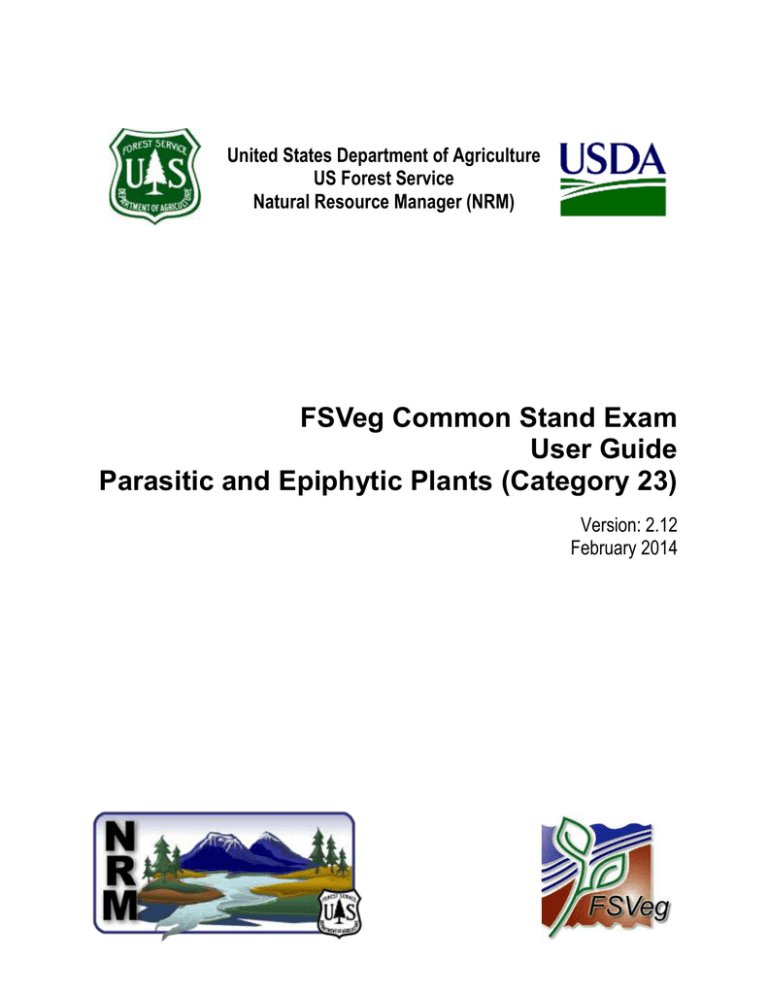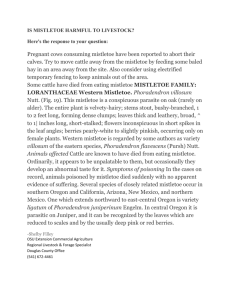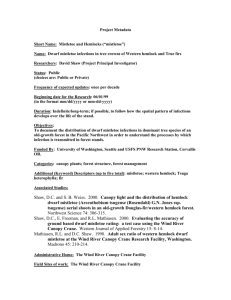FSVeg Common Stand Exam User Guide Parasitic and Epiphytic Plants (Category 23)
advertisement

United States Department of Agriculture US Forest Service Natural Resource Manager (NRM) FSVeg Common Stand Exam User Guide Parasitic and Epiphytic Plants (Category 23) Version: 2.12 February 2014 TABLE OF CONTENTS (23-001) Mistletoe ........................................................................... 2 Dwarf Mistletoe Severity Rating Instructions ........................................ 2 (23-002) Parasitic Plants ................................................................. 3 (23-005) White Fir Dwarf Mistletoe .................................................. 3 (23-006) Lodgepole Pine Dwarf Mistletoe ........................................ 4 (23-007) Apache Dwarf Mistletoe ..................................................... 6 (23-008) Western Dwarf Mistletoe ................................................... 6 (23-009) Limber Pine Dwarf Mistletoe ............................................. 6 (23-010) Pinyon Dwarf Mistletoe ..................................................... 7 (23-011) Douglas-Fir Dwarf Mistletoe .............................................. 7 (23-012) Chihuahua Pine Dwarf Mistletoe ........................................ 8 (23-013) Larch Dwarf Mistletoe ....................................................... 8 (23-014) Western Spruce Dwarf Mistletoe ....................................... 9 (23-015) Eastern Dwarf Mistletoe .................................................... 9 (23-016) Hemlock Dwarf Mistletoe................................................. 10 (23-017) Southwestern Dwarf Mistletoe ........................................ 11 (23-018) Dodder ............................................................................ 12 (23-019) White Fir Mistletoe .......................................................... 12 (23-020) True Mistletoe ................................................................. 13 (23-021) Red Fir Dwarf Mistletoe ................................................... 13 (23-022) Juniper True Mistletoe ..................................................... 14 FSVeg Common Stand Exam User Guide i Insects & Diseases: Parasitic & Epophytic Plants (Category 23) (23-001) MISTLETOE Description: Mistletoe plants are small, ranging in height from one-half inch or less on Douglas-fir to 3 inches or more on ponderosa pine. Plants are yellow to yellow-green to olive-green in color. Branches swell and become spindle-shaped at the point of initial infection. However, the most conspicuous symptom is formation of witches’ brooms, which often develop within a few years of infection. Brooms are spherical clumps of abnormal branch and twig growth; usually exhibiting lighter colored and sometimes smaller needles than normal branches. Other insects, pathogens, and physical or genetic influences may cause broom formation. Large, older, opengrown trees may appear to have swollen branches. When in doubt, associate dwarf mistletoe plants with swellings and brooms before identifying them as caused by dwarf mistletoe. Dwarf mistletoes are parasitic plants that depend on conifer hosts. Their modified root system is embedded in bark and wood tissues. The aerial shoots are reproductive structures. Although they do contain chlorophyll and manufacture some carbohydrates, most of their carbohydrates and all of their water and minerals come directly from the host. Dwarf mistletoe infection is characterized by reduction in growth. Height growth is generally more seriously affected than diameter growth. Mistletoe plants are either male or female; both sexes may be found on the same host tree. The pathogen spreads by sticky seeds "shot" from the female mistletoe plant; most seeds (90 percent) land within 50 feet. After an infection is established, it takes 3 to 4 years to reach maturity. Rate of spread within an even-storied stand is about 2 feet per year. Severity rating for dwarf mistletoe is coded 1 through 6 according to the following system: DWARF MISTLETOE SEVERITY RATING INSTRUCTIONS Step 1: Divide live crown into thirds. Step 2: Rate each third separately. Each third should be given a rating of 0, 1, or 2, as described below: (0) No visible infections. (1) Light infection (½ or less of the total number of branches in the crown third are infected). (2) Heavy infection (more than ½ of total number of branches in the crown third are infected) FSVeg Common Stand Exam Users Guide 2 Insects & Diseases: Parasitic & Epophytic Plants (Category 23) Step 3: Finally, add ratings of thirds to obtain rating for total tree. In the example below, the dwarf mistletoe rating is 3 (top (0) + middle (1) + bottom (2)). Figure 1: Sample: tree divided into thirds (23-002) PARASITIC PLANTS Description: More than 250 species of higher plants are known to live parasitically on other plants. These parasitic plants produce flowers a seeds similar to those produced by the host plants. Mistletoes and dodders are examples of parasitic plants. Mistletoes do not have roots, and depend on the host for water and all minerals. Dodders depend entirely on their hosts for their existence. (23-005) WHITE FIR DWARF MISTLETOE Species: Arceuthobium abietinum f. sp. Soncoloris Host: White fir, grand fir Secondary host: Brewer spruce, subalpine fir Range: The Cascade Mountains of S. Washington, Oregon, and northern California, the Siskiyou Mountains of S. Oregon and N. California, and in the Sierra Nevada Mountains in California. FSVeg Common Stand Exam Users Guide 3 Insects & Diseases: Parasitic & Epophytic Plants (Category 23) Figure 2: Distribution (23-006) LODGEPOLE PINE DWARF MISTLETOE Species: Arceuthobium americanum Host: Lodgepole pine Secondary host: Jeffery pine, limber pine, whitebark pine, ponderosa pine, Englemann spruce, blue spruce, bristlecone pine Range: Throughout the range of the lodgepole pine in North America Injury: A native, parasitic, seed plant. It is the most damaging disease agent in lodgepole pine, causing severe growth loss and increased tree mortality. Surveys in the Rocky Mountains show that the parasite is found in one- to two-thirds of commercial lodgepole pine stands. Recent assessments of the effects of lodgepole pine dwarf mistletoe in Montana, Colorado, and Wyoming indicate that the annual loss exceeds 40 million cubic feet per year. Figure 3: Male plant FSVeg Common Stand Exam Users Guide 4 Insects & Diseases: Parasitic & Epophytic Plants (Category 23) Figure 4: Female plant Figure 5: Distribution Figure 6: Brooms Figure 7: Trunk distortion FSVeg Common Stand Exam Users Guide 5 Insects & Diseases: Parasitic & Epophytic Plants (Category 23) (23-007) APACHE DWARF MISTLETOE Species: Arceuthobium apachecum Host: Apache pine Range: Southern Arizona and central New Mexico (23-008) WESTERN DWARF MISTLETOE Species: Arceuthobium campylopodum Host: Ponderosa pine, Jeffery pine, knobcone pine, Coulter pine Injury: This is one of the most damaging forest diseases in the Western United States. The presence of branch swellings and serial shoots of the plant are conspicuous indications of infection. Brooms may form. On larger trees, they become well developed and are easily observed. Swelling because of trunk infection is not as pronounced as that in true firs. However, in some cases, old trunk infections result in open, pitchinfiltrated bole cankers. (23-009) LIMBER PINE DWARF MISTLETOE Species: Arceuthobium cyanocarpum Host: Limber pine, whitebark pine, bristlecone pine Secondary host: Western white pine, foxtail pine, lodgepole pine, mountain hemlock Description: A small, parasitic flowering plant. The external shoots are yellowgreen, have inconspicuous scale-like leaves at the nodes, and are perennial. Plants are typically densely clustered around infected tree branches. On the average, plants are only 1 inch tall, but they are sometimes as tall as 3 inches. Aerial shoots arise from a network of root-like, absorbing strands imbedded in host tissues. Figure 8: Distribution FSVeg Common Stand Exam Users Guide 6 Insects & Diseases: Parasitic & Epophytic Plants (Category 23) Figure 9: Female shoots (23-010) PINYON DWARF MISTLETOE Species: Arceuthobium divaricatum Host: Pinion Range: California, Nevada, Utah, Colorado, Arizona, New Mexico, Texas (23-011) DOUGLAS-FIR DWARF MISTLETOE Species: Arceuthobium douglasii Host: Douglas-fir Secondary host: Fir, spruce Range: Not found east of the Continental Divide in Montana, most of Wyoming, northern Colorado, and west of the Cascade Range (except near the crest) and north of the Siskiyou Mountains of Oregon Figure 10: Distribution FSVeg Common Stand Exam Users Guide 7 Insects & Diseases: Parasitic & Epophytic Plants (Category 23) Figure 11: Aerial shoots (23-012) CHIHUAHUA PINE DWARF MISTLETOE Species: Arceuthobium gillii Host: Chihuahua pine Range: Arizona, New Mexico (23-013) LARCH DWARF MISTLETOE Species: Arceuthobium laricis Host: Western larch, mountain hemlock Secondary host: Lodgepole pine, whitebark pine, subalpine fir, grand fir, ponderosa pine, Pacific silver fir Figure 12: Distribution Figure 13: Female flowers FSVeg Common Stand Exam Users Guide 8 Insects & Diseases: Parasitic & Epophytic Plants (Category 23) Figure 14: Witches broom (23-014) WESTERN SPRUCE DWARF MISTLETOE Species: Arceuthobium microcarpum Host: Englemann spruce, blue spruce, bristlecone pine Range: Arizona, New Mexico (23-015) EASTERN DWARF MISTLETOE Species: Arceuthobium pusillum Host: Black spruce, white spruce, red spruce Secondary host: Blue spruce, jack pine, red pine, eastern white pine Figure 15: Basal cups on infested branch Figure 16: Basal cups on infested branch FSVeg Common Stand Exam Users Guide 9 Insects & Diseases: Parasitic & Epophytic Plants (Category 23) Figure 17: Aerial mistletoe shoots (23-016) HEMLOCK DWARF MISTLETOE Species: Arceuthobium tsugense Host: Western hemlock, Pacific silver fir, subalpine fir, noble fir, grand fir, lodgepole pine Range: Alaska, Washington, Oregon, California Figure 18: Female plant Figure 19: Swelling and aerial shoots on hemlock FSVeg Common Stand Exam Users Guide 10 Insects & Diseases: Parasitic & Epophytic Plants (Category 23) Figure 20: Mistletoe burl Figure 21: Young broom (23-017) SOUTHWESTERN DWARF MISTLETOE Species: Arceuthobium vaginatum subsp. Crytopodum Host: Ponderosa pine, Apache pine, Arizona pine, lodgepole pine Secondary host: Limber pine, bristlecone pine, southwestern white pine Range: Throughout the range of ponderosa pine from northern Mexico through western Texas, Arizona, and New Mexico into Colorado and central Utah. Figure 22: Southwestern dwarf mistletoe plant features A = cluster of female shoots; B = male flowers; C = mature berries; D = germinated seed FSVeg Common Stand Exam Users Guide 11 Insects & Diseases: Parasitic & Epophytic Plants (Category 23) Figure 23: Southwestern dwarf mistletoe deformities A = single witches’ broom; B = witches’ brooms scatter throughout crown; C = witches’ brooms in a tree killed by dwarf mistletoe (23-018) DODDER Species: Cuscuta spp. Description: This is a form of a parasitic plant. Dodders are most serious in the southern half of the country. Dodder affects the growth and yield of the host plant and causes losses ranging from slight to complete destruction. Dodder may also serve as a bridge for transmission of viruses from virus infested to virus free plants. Symptoms are orange or yellow vine strands, which grow and entwine around the stems of plants. Dodder forms dense tangles of leafless stands on and through the crowns of host trees. The growing tips reach out and attack adjacent plants, until a gradually enlarging circle of infestation, up to 10 feet in diameter, is formed by a single dodder plant. During late spring and summer, dodder produces massed clusters of white, pink, or yellowish flowers, which soon form seeds. The host tree becomes weakened, vigor and yield declines. (23-019) WHITE FIR MISTLETOE Species: Phoradendron bolleanum subsp. pauciflorum Host: White fir FSVeg Common Stand Exam Users Guide 12 Insects & Diseases: Parasitic & Epophytic Plants (Category 23) Injury: This affects only larger and older trees. Many years are required for it to build up and become damaging, in some cases it becomes so dense that treetops and entire trees are weakened and doe or are attacked and killed by bark beetles. This mistletoe is most often observed in the tops of the tallest trees in the stand. Large clumps of foliage may grow along the trunk of the tree for 20 to 30 feet down from the top. Often the tree foliage in this zone is nearly completely replaced by mistletoe foliage. Spike tops are common. The dead mistletoe shoots remain attached to the dead tops and branches for some years after death. Description: The leaves are smooth, oval shaped, about 0.2 to 0.4 inch wide and 0.5 to 1.2 inches long Defect: One conk may indicate at least 16 feet of decay in each direction. Three to four punk knots or two or more conks indicate complete cull. On hemlock, a single conk indicates total heartwood loss. (23-020) TRUE MISTLETOE Species: Phoradendron spp. Host: Incense cedar, juniper, oak Injury: True mistletoes are parasitic plants that depend on their hosts for water and nutrients. They produce conspicuous, yellow-olive green balls or clumps of foliage. True mistletoes are less often associated with brooms and deformities than dwarf mistletoes. Positive identification should be based on presence of plants. (23-021) RED FIR DWARF MISTLETOE Species: Arceuthobium abietinum f. sp. Magnificae Host: California red fir, Shasta red fir Range: Cascade Mountains of Oregon and N. California, the Siskiyou Mountains of S. Oregon and N. California, and in the Sierra Nevada Mountains in California. FSVeg Common Stand Exam Users Guide 13 Insects & Diseases: Parasitic & Epophytic Plants (Category 23) (23-022) JUNIPER TRUE MISTLETOE Species: Phoradendron juniperum Host: Juniper Injury: Although this mistletoe builds up to high populations in some trees, the damage appears to be negligible. Description: This species appears as upright clumps of shoots in the crowns of trees. It does not have leaves. The leaves are reduced to inconspicuous scales less than 1/16 inch long. Berries are light pink. FSVeg Common Stand Exam Users Guide 14 Insects & Diseases: Parasitic & Epophytic Plants (Category 23)





